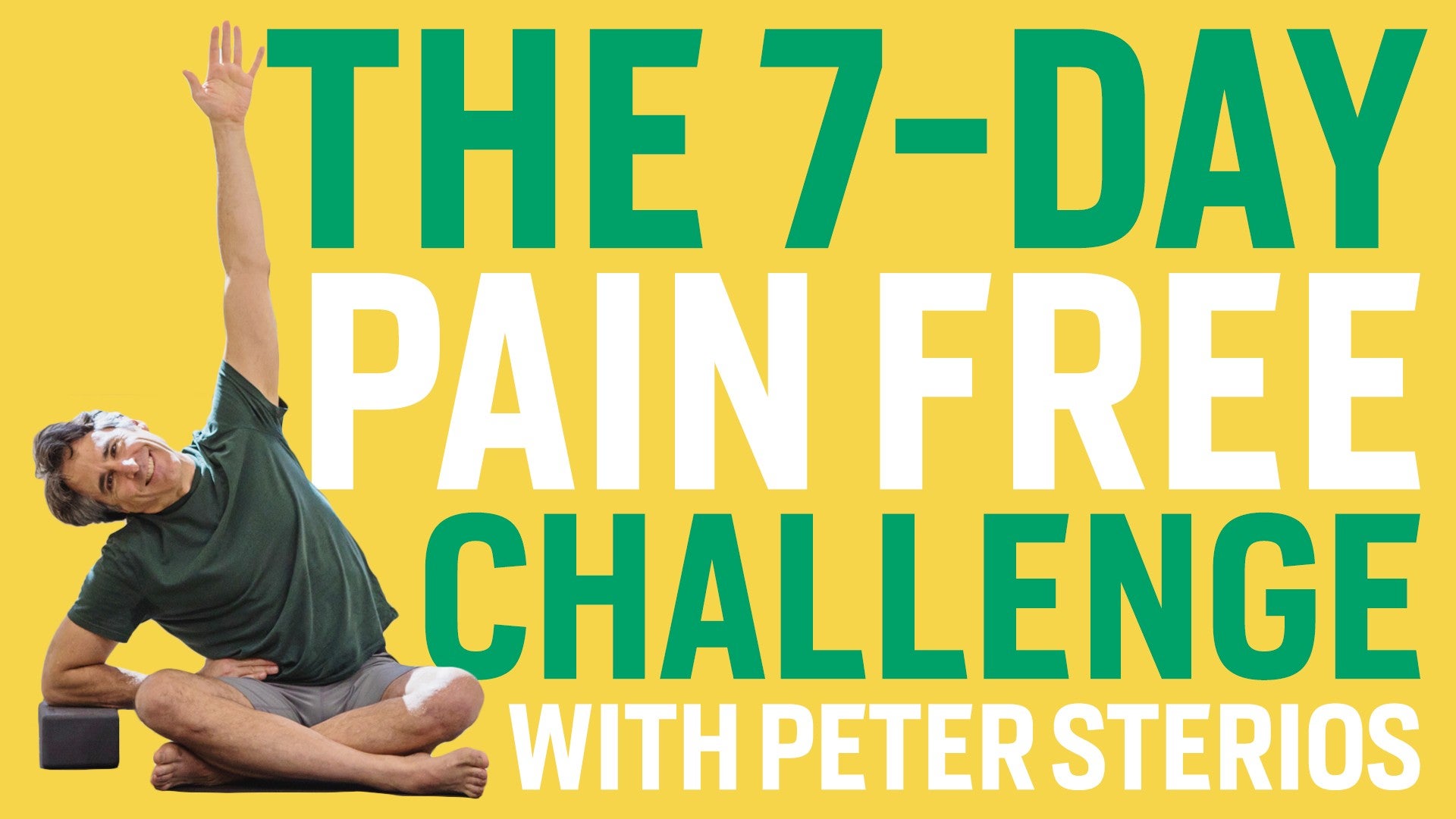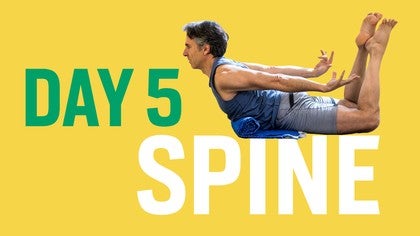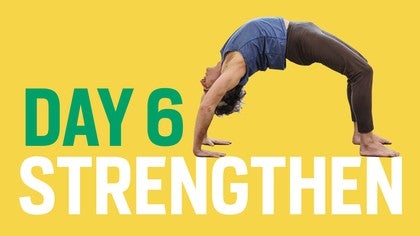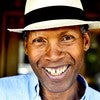Description
About This Video
Transcript
Read Full Transcript
Welcome to day seven and congratulations for being with us. This last practice is really almost like a graduation for this pain-free challenge and I like to refer to it as yoga massage and it's mostly restorative type practices. So let's begin on our backs, starting with wrapping the arms around the legs, clasping either the elbows or the wrists, pulling the chin down a little towards your throat, consciously slowing your breath down, following the fullness of your breath into the back and sides of your lungs and with each exhale, softening the hip creases where the thigh and pelvis meet, softening the belly and ribs and gently hugging your knees tighter into your chest. Three to four second inhale through the back and sides of your lungs, taking it all the way into the pelvic floor, three to four second exhale, softening through the hips, belly and ribs, hugging the knees. As the spine lengthens, occasionally pulling the chin down a little, capturing that length that naturally occurs as you release through the intercostal muscles, then holding onto your right knee, straighten your left leg to the floor, extending through the heel.
Here breathing more into the left lung, following the breath, fully left, each exhale, soften the right hip crease, hug the right knee tighter, extend through the left heel, pressing the back of the left knee a little flatter. If you can, grabbing the foot with both hands, use a belt if you need to, pull the chin down a little toward your throat, keep your neck long. So the right knee is inside the right arm, breathing into the left lung. On the exhale, soften the hip crease, soften the rib cage, bend your arms a little, hug the knee tighter against your chest. Keep the left leg working, strongly extending through the heel.
Slowly let the right knee slide off the side of your chest, keep your shin bone as vertical as you can, move your tension into the right groin, releasing the grip in the groin, and as you soften into the groin, the knee drifts laterally out to the side, and as you feel the drift, gently engage the arm, pull the knee a little lower, each inhale, breathing through the back, the full length of the torso, each exhale, softening the groin, feel the knee drift a little out, simultaneously bend the arms a little, pull the knee lower. If your right knee is not on the floor, I'd like you to roll to the right till the knee is on the floor. Once you feel the knee grounded, keeping that shin bone vertical, lift your left leg up. With an exhale, slowly descend the left leg to the right, and as the leg drops off in your pubic bone, feel the left ilium converge on the pubis, keep the left heel engaged. Breathe through the back, following the breath into the pelvic floor, each exhale, soften the groin and pubis, feel the left ilium converge, left heel drops, and simultaneously pull the right foot towards your face with the arms.
With an inhale, swing the left leg back to your mat, and change legs. Hug the left knee to your chest, straighten the right leg to the floor, pull the chin down a little towards your throat, keep your neck long. Breathe into the right lung. On the exhale, soften the left hip crease, left ribcage, hug the knee in a little tighter, extending through the right heel, back of the knee dropping towards the floor. Keeping the left knee on your chest, grab the foot with both hands, using a belt if you need to, gently pulling the foot down, pressing the knee against your ribcage.
Keep breathing into the right lung. On the exhale, softening into the left hip crease, belly, and ribs, simultaneously engage the arm a little more, pulling the knee lower onto the chest. And now letting the left knee slide off the side of the ribs, move your attention into the left groin, softening. As you release the groin, the knee drifts laterally out to the side as the knee drifts. Engage your arms a little, pull the knee a little lower.
Be patient. Each inhale you can let your knee lift a little as the breath moves into the pelvic floor. Each exhale, re-release the groin, knee drifts simultaneously, engage the arms, pull the knee lower. Keep working the right leg strongly, extending through the heel, pressing the back of the right knee flatter. If your left knee is not on the floor, I want you to roll to the left until the knee is on the floor, keeping the left shin bone as vertically as possible.
Lift the right leg up. Keeping the heel flexed, lower the right leg to the left. Extending through the heel, on the way down, softening the pubis. Feel the right ilium bone, hip bones converging on the pubis, simultaneously pulling the left foot towards your face. Breathing through the back body into the pelvic floor.
Each exhale, release the sphincter muscles, soften the pubis and the skin below your navel. Pull the left foot towards your face. With an inhale, sweep the leg back to the mat, bend both knees to your chest, wrap the arms around the legs, pull the chin down towards your throat, and gently rock your legs side to side. And then releasing the legs, slowly sit up. And we're going to work with tennis balls.
I'd like you to use two tennis balls and we'll also need a block. Preferably a cork block comes in handy. We'll start by lying down on our backs. We can start with the block as a pillow just to warm up the neck a little. You can keep your knees bent, feet flat.
Slow breathing through the back. Each exhale, softening the diaphragm, feel your abdominal organs dropping, softening the top of the lung, feel your heart dropping. Softening your throat, feel the thyroid dropping. Notice as the thyroid sinks, the chin drops a little and you feel more lengthening in the neck, passive lengthening. And now we'll add the tennis balls.
So grabbing the balls, one in each hand, lift your head up off the block. You may need to scoot a little closer to the block. You want the balls directly on top of the block together. You can use your fingertips to push the balls so they stay together, positioned right at the base of your skull. Like before, we're breathing through the back, the full length of your torso.
Each exhale, top of the lungs softens, heart drops a little, throat softens, chin drops a little, and you're trying to release the full weight of your head onto the balls. As you feel the head settling into the balls, gently rock your face side to side, gently. And gently rock your face up and down, side to side. Up and down. Then pause.
Try and release the full weight of your head onto the ball. Now we'll scoot a little closer to the block. Lift your head, move the balls a little lower, right into the center of your neck. Bring the balls together with the tip of your fingers, elbows resting on the floor. Try and release the full weight of your head onto the balls.
And now gently rocking the face side to side. Gently rock the face up and down. Side to side. Up and down. Then let the head rest.
Release the full weight of the head onto the balls. Each exhale top of the lungs softens, heart drops. Bring the hands back to the ball. Remove one of the balls, slowly roll to your right, and placing the ball right on the insertion where the sternocleidomastoid muscle, that big muscle on the side of your neck, inserts into the base of the skull. And you can change the angle of your face a little until you find that tender spot, and it'll let you know.
And when you find it, pause there, stay right on it, and release the full weight of your head onto the ball. Each exhale, soften the top of the lung, feel your heart sink, releasing more weight of the head onto the ball. And gently rock your face side to side. Gently rock your face up and down. Side to side.
Up and down. And pause, resting, release the full weight of your head onto the ball. With an inhale, slowly lift your head, move to the other side, placing the ball right where the SCM muscle inserts into the base of the skull, on top of the block, adjusting the angle of your face. Until you find that tender spot that speaks to you, try to release the full weight of your head onto the ball. Each exhale, top of the lung, softens, heart drops.
Feel more weight of the head sinking into the ball. And gently rock your face side to side, gently rock your face up and down. Side to side. Up and down. And let your head rest, releasing the full weight of your head onto the ball.
Keep your breathing slow. And then slowly release the ball, lifting the head. Roll back to the first side. We're going to move the block out of the way. And now we're going to roll onto the right side.
And you want to place the ball on the floor beside the shoulder, about an inch below the head of the shoulder, and roll up onto the ball. And intuitively you're going to roll around until you feel something tender right in the heart of the deltoid muscle. Keep your right arm beside you. When you find that spot, stay on it, sinking into the ball. And to support your head, lightly clench your fist, and turning the face down, support your forehead on the fist.
Breathe into your right shoulder, like the tennis ball is part of your lungs. Each exhale, soften the top of the lung, feel your heart sinking, feel gravity pressing you into the ball a little more. Keep your belly and butt soft. Now lift your head, and intuitively, let's find another spot adjacent to the one you are on. See if you can find another spot nearby that's tender.
And when you find it, sink into it, and to support your head, lightly clench the fist, support your forehead. Each exhale, top of the lung, softens, heart drops. Place the full weight of your head onto the ball, belly and butt soft. With an inhale, lift your head, removing the ball, sweep the right arm straight out to the side in line with your shoulder. You want the block nearby.
You're going to lean back, lift the arm off the floor, and put the ball right behind your armpit, and then, dropping the arm, roll up onto the ball, and you're going to find something tender right where the latissimus muscle inserts into the top of the deltoid muscle. And this one really speaks to you. Keep that right arm passive. Use the block here for a pillow. If your shoulders are wide, you can tilt the block up.
If your shoulders aren't so wide down, let your head rest on the block. Breathe into the right shoulder like the tennis ball is part of your lungs. Each exhale, top of the lung, softens, heart drops. And slowly bend the arm, forearm vertical, and with a soft fist, circle the forearm, and change direction. Keeping the forearm vertical, with the other hand, grab the fist, and gently press the fist down towards your feet.
And then slowly press the fist forward towards the crown. And release the arm out to the side. We'll find one more spot. It doesn't take much. You're intuitively moving to an adjacent spot.
When you find it, let your head rest. Always lots of excitement in here. And bend in the arm, forearm vertical, with a soft fist, circle the forearm. Other direction. With the opposite hand, grab the fist, slowly press the fist down towards your feet.
And slowly press the fist forward towards your head. Alright, release, remove the ball, and we'll move to the other side. Move the block out of the way. Clear the left arm right beside you, placing the ball on the floor next to your arm an inch below the head of the shoulder. Roll up onto the ball, intuitively rolling on the ball until you find something tender in the deltoid.
When you find it, stay on it, sink into the ball, and to support your head, soft fist, turning your face down, resting the forehead on your fist. Breathe into the left shoulder. Each exhale, top of the lungs softens, heart drops, gravity pressing you into the ball. After two or three cycles of breath, lift your head, again intuitively rolling around, not much, until you find something adjacent to where you were that's tender. When you find it, pause there, again supporting your forehead on the fist, breathing into your left shoulder.
Breathe into the left shoulder like the tennis ball is part of your lungs. Feel the expansion of the breath into the ball. Each exhale, top of the lungs softens, heart drops, gravity pulls you onto the ball deeper. Forehead at rest on the fist. Okay, inhale, lift the head, coming off the ball, move your left arm straight out to the side, move the block in if you need it for the pillow.
Lean back, lift the arm away from the floor, placing the tennis ball right where the latissimus and the deltoid meet, and then intuitively rolling around on the ball until you find a tender spot that speaks to you, and then supporting the head with the block, let the full weight of your head rest on the block. Breathe into your left shoulder. On the exhale, top of the lungs softens, heart drops, feel the gravity moving you deeper onto the ball. And then bending your left arm, forearm vertical, with a soft fist, circle your forearm. Change direction, circle the other way.
With your right hand, grab the left fist, gently press the fist down towards your feet. And slowly press the fist forward towards the crown. And release the left arm out to the side, lift your head off the block intuitively, roll around, find an adjacent point. When you find it, stay right on it. Let your head rest.
Slow your breath down, breathing into the ball like it was part of your lungs. Each exhale, top of the lungs softens, heart drops, belly and butt soft. And bending the left arm, forearm vertical, with a soft fist, circle the forearm. Change direction. With the right hand, grab the fist, slowly press the fist down towards the feet.
And slowly press the fist forward towards the head. And release. Slowly coming up off the ball, moving the block out of the way, actually move it forward. And now we're going to lay down on the back, and I'll just show you where the placement of the ball is going to go here. We're going to place the balls together right where the trapezius muscle meets the base of the neck, and you want to start with the balls together, and you can use your fingertips to hold them in.
So, lay down, and you want the block about arm distance length away from you. Place the tennis balls together right at the base of the neck, and if you need to, use your fingertips to gently press the balls together, and then releasing the arms beside you, palms turned down, walk your feet in a little, and then slowly lift your hips up without rolling forward. As the hips lift, the chin will drop, you can extend the back of the skull along the mat to keep your neck long. Breathe through the back, again visualizing the tennis balls as part of your lungs to breathe into. Each exhale top of the lung softens, heart drops, press into your feet, lift your hips a little higher, and now lift your arms vertically upward, palms face each other, and slowly lift your shoulders away from the floor, extending up to the fingers.
Keeping the fingers extending, relax your shoulders down towards the floor. Again, lift the shoulders away from the floor, relax the shoulders into the floor. Keeping the shoulders down, slowly lower the arms over the head, and find the ends of the block for your palms, so you're squeezing the ends of the block with your palms, fingers extend beyond. Tuck your tailbone up a little, and slowly lower the hips, and what you're trying to do is get your kidneys on the floor before you're sacred. Keep your arms engaged, pressing the sides of the block, keep the block on the floor, go straight if you can, once your hips reach the floor, actually pull the navel down and flatten the lumbar into the floor, keep squeezing the block with your hands, and then release.
Arms beside you, walk the feet in a little, we're going to roll forward now, the ball moves down from that top of the trapezius right into the top of the shoulder blade. So right on the top edge of the shoulder blade, the balls rest, and you're going to slowly lift the hips again without rolling forward. As the hips come up, the chin drops, breathing through the back, targeting the balls with your breath. Exhale, top of the lung softens, heart drops, lift your hips higher. Then lift your arms up, palms face each other.
Slowly lift the shoulders away from the floor, extending through the fingers, and slowly relax the shoulders into the floor. Then lift the shoulders, extend through the fingers, relax the shoulders as they descend. Keeping the shoulders down, slowly lower the arms over the head, squeezing the ends of the block, push the block away from you, arms straight. As you squeeze, keep the block on the floor, tuck the tailbone up a little, slowly lower the hips. Go slow here, this is getting more intense.
When the hips reach the floor, pull the navel down, flattening the lower back. And then last one, hands to the floor again, walk the feet in a little, keep sliding forward until the balls are right behind your heart, along the inner edges of the shoulder blades. When you feel them set, slowly lift the hips up without rolling forward. And into the back of the heart, following the breath into the tennis balls. Each exhale, top of the lungs, softens, heart drops, lift your hips a little higher.
Pull the chin down a little lower. And now both arms vertical, this is a pretty exciting one. Relax and extend the shoulders up, extending through the fingers, and slowly release the shoulders down. Again lift the shoulders, extend through the fingers. Release the shoulders down, keeping the shoulders down, slowly lower the arms over the head.
Squeeze the ends of the block, slowly lower the hips, keep the tailbone tucked. Keep breathing through the back body, exhale, soften the diaphragm, soften the top of the lungs, keep the tailbone tucked. When your hips reach the floor, pull the damble down. With an inhale, release, roll to the side, sit up. That completes the tennis ball cycle.
Now we're going to move to the wall. And it's handy to have a strap. Laying down on your side, you want to push your butt cheeks to the wall on your side. So you feel firm contact with the buttocks against the wall. And then when the butt is firm against the wall, straighten your legs up.
With the belt, you want to loop the belt over your legs, right across the center of your thighs. And when you put the strap in the right position, tighten the strap, snug. So you feel that firmness of the support of the strap against your legs. When the arms go over the head, elbows bent slightly, forearms parallel. It's like you're impersonating a swirled cactus on the floor.
Close your eyes. Release all effort in the legs without the knees bending. So there's just a little bit of effort to keep the legs from bending. Breathe through the back, the full length of your torso. Only as if you could breathe into the wall where the pelvic floor meets the wall.
Each exhale, release the sphincter muscles and the skin below the navel. Soften the diaphragm, soften the top of the lungs. Feel the abdominal organs and heart sinking, arms heavy on the floor, hands passive. Three to four second inhale, three to four second exhale. Literally visualize your internal organs resting on your spine.
Heart resting on the thorax, thyroid resting on the cervical spine, abdominal organs resting on that lumbar spine, genitals resting on the coxal and lower sacral part of the spine. Keep the sound of your breath soft, the texture of your breath smooth. Feel the circulation in your legs draining down into your pelvis. So it's as if your legs were hollow, all the fluid of the legs pooling in the pelvis. And you feel that fullness, warm softness of the pelvis.
Turn the gaze of your eyes down as if you're looking under your cheekbones and softening the optic muscles behind the eyeballs. Feel the weight of the eyeball dropping deep into the sockets. Soften the frontal lobe of the brain, feeling the tissue of the brain pulling away from the inner forehead slightly. Feel softness in the temples and the corners of the mouth like an inner smile to yourself. Feel the fullness of the silence that surrounds you, the sound only of that soft inner quality of your breath.
Even if there's external noise, your attention is turned inward, focusing just on that inner sound, soft, slow and smooth of your breath. You may also feel the beat or hear the beat of your heart. Keep the gaze of your eyes turned down, eyeballs heavy deep into the sockets like they were resting on your upper jawbones. When you make that connection where the eyeball feels like it's resting on the upper jawbone, notice the soft fullness it creates in your cheeks. Make that soft fullness into the hinge of your jaws, completely release the grip in your jaw hinge, soften the sides of the tongue.
When you're ready, slowly bend your legs, hook your thumbs under the loop of the strap and just slide the strap up off your feet. Roll to your right side, spend a moment here, knees bent in a fetal position, head resting on the right arm. Notice the warmth that radiates around the sacrum and the back of the heart. Feel the fullness of your breath into the front side and back of your lungs. Keeping your eyes closed, slowly make your way up to sitting.
Spend a moment sitting with the eyes closed, hands resting on the knees, head upright. It's like you're re-acclimating yourself to an upright world, deep quality of stillness sitting. Now open your eyes to prepare for a seated meditation. I'd like you to use your strap, if it's a 10 foot strap, it's perfect for this. If you're using an 8 foot strap or shorter, you'll need to buckle up two straps together and you want to open up the loop almost all the way so there's about a foot of strap on the outside of the buckle and to test, your arms fully extend out to the side hooked with your thumbs, you have that perfect extension of the arm and the strap is the exact same length.
Then you'll drop the strap behind you and one knee at a time you're going to loop the strap around the front of the knee right where the bottom edge of the kneecap and the head of the shin bone meet, there's a little notch, you put the strap right into that notch. For the other side, you want to lean forward placing the strap and when you sit upright, make sure one on the back of the strap, one is right across your sacrum, the other one is right across your kidneys. So sacrum kidneys with the strap and you can adjust the, if you need less or more tension, you can adjust the buckle a little bit. And then hands rest on the knees, head upright, consciously slow your breath down. Here breathing into the front side and back of the lungs.
Each exhale, you want to feel this softening through the chest, through the diaphragm, through the belly, organs drop and with the strap supporting your kidneys and sacrum, the pelvis is completely passive without the spine collapsing and the spine slightly engaged from the back of the skull, chin slightly in towards your throat, but the head perfectly positioned over the neck where you have a sense that it's weightless. The head is weightless. And now with as little movement as possible, bring your right hand up, place the forefinger and middle finger right on the third eye. The tip of your thumb goes into the right nostril, the ring and pinky finger squeeze together and right on the left nostril. And you want the fingertips right where the hard cartilage of the nose meets the soft cartilage of the nose.
And there's a little groove if you palpate that intersection between hard and soft cartilage, setting the fingertips right into the groove. And as you gently rest your hands here, I want you to gently close the left nostril, opening the right and with an inhale, slowly inhale. When you're comfortably full, hold your breath, slowly close the right nostril, open the left and then exhale slowly. In your left nostril open, slowly inhale. When you're comfortably full, close the left nostril, open the right, slowly exhale.
Keeping the right nostril open, slowly inhale, breathe as slowly as you can. When you're comfortably full, block the right, open the left, slowly exhale. Keeping the left open, slowly inhale. When you're comfortably full, closing the left, open the right, exhale. When you finish that exhale, release the hand back to the knee, keep your head upright, breathing through both nostrils slowly.
Each exhale, we release the shoulders, arms heavy, hands heavy, spine light, lifting gently from the back of the skull, organs descending. Now moving your attention to the tip of your nostrils, exhale slowly. And now inhaling slowly, follow the cool expanding sensation of your in-breath from the tips of the nostrils to the third eye, converging on the third eye. When you're comfortably full, follow the exhale from the third eye back to the tips of the nostrils. The energy of the exhale is warm and soft.
Each inhale following the breath, that cool expansive quality of your inhale from the tip of the nostrils to the third eye, meeting at the third eye. Each exhale from the third eye, warm softening back to the tips of the nostrils, diverging. One more, slow inhale, cool expansive to the third eye. Slow exhale, warm softening to the tips of the nostrils. Now in this inhale, inhale from the right nostril, cool expansive to the third eye.
So you're visualizing that energy. At the third eye, warm softening exhale to the left nostril. With the inhale, left nostril to third eye, cool expansive, exhaling third eye to right nostril, warm softening. One more round like that, cool expansive, right nostril to the third eye. Inhale warm softening third eye to the left nostril.
Inhale cool expansive left nostril to the third eye, warm softening third eye to right nostril. And now resume normal breathing, slow both nostrils. Place your shoulders, arms heavy, hands heavy, spine light and lifting through the back of the skull. If you feel any discomfort in your body, take the fullness of your inhale into your discomfort. Feel the subtle expansion pressing into that spot.
Each exhale, warm softening into your discomfort, feel the space open around it, visualizing gravity pulling your discomfort down into the ground beneath you. Both the physical discomfort and the mental discomfort on the exhale cycle descends into the ground, spine light and lifting through the back of the skull. The sound of your breath soft, the rhythm of your breath slow, the texture of your breath smooth. With as little movement as possible, with one hand slide the belt off one of the knees. Just let that side of the belt drop, maintaining that position as if you were still supported.
When you feel that virtual support, slide the other strap off, maintaining that idea of support the belt provided, but creating your own support, spine lifting gently from the back of the skull. Slowly bring the hands together at your heart, feel the gratitude of your mind and the willingness of your body to create this opportunity for yourself. Thank you.
The 7-Day Pain Free Challenge
Comments
Thanks for the enjoyable, informative practice.
You need to be a subscriber to post a comment.
Please Log In or Create an Account to start your free trial.






















